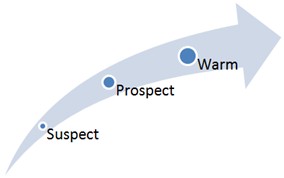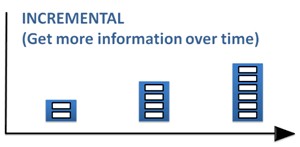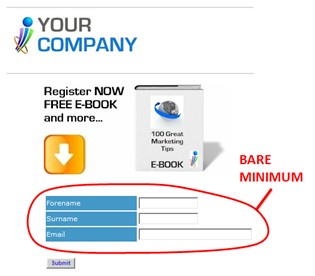
I was once on a Boys Night Out, and my mate, (under the influence) walked up to a girl at the bar, and with underlying amorous intentions, started asking her all sorts of personal questions. She “looked daggers” at him (as we say up North). Abject failure on his part.. The point here is that there is a time and a place for things in a relationship, and he got his timing badly wrong by asking for way too much information “up-front”.
I went to register for a white paper from a very large, well-known global software company. Sadly – I counted 28 (twenty eight) separate pieces of information on the registration page!. It was the equivalent of them saying “Tell me your life story”, on this very first tentative encounter.
Both my mate, and the large software company have forgotten that in any relationship the dynamics build over time: The shape of the engagement curve above gives the clue really. We can’t expect people to provide their life story right at the start. By capturing information piece by piece over time (incrementally), we can ensure that we are aligned with the natural, underlying, human dynamics. Remember, when someone registers on your web-site, they are actually doing a couple of things (at least):
The shape of the engagement curve above gives the clue really. We can’t expect people to provide their life story right at the start. By capturing information piece by piece over time (incrementally), we can ensure that we are aligned with the natural, underlying, human dynamics. Remember, when someone registers on your web-site, they are actually doing a couple of things (at least):
Spending some of their valuable time. (Might seem trivial, but on the web, every second counts).
Taking a risk, because they don’t know whether their registration will just disappear into a black hole.
The key is to start small (softly softly), and ask for more over time:
Technology can help by automating this process. The first registration page should really ask for the bare minimum: forename, surname, email is usually enough on the first encounter. The other important thing is to try and support the persons own agenda. In a B2B web situation , this usually means giving them something of genuine value (e.g. white paper, hints and tips, etc.) right from the start.
This “Give-Get” orientation is important. People come to your web site, not to see how great you are, but because they have their own agenda, such as finding out more about a certain subject area, looking for things to help them justify a proposal to their boss, etc.
By embracing that agenda, and giving something of value, (and a quick Email acknowledgement), you are starting the online relationship off in the right way. Once email address is captured, you can keep those people in the loop, with different announcements, offerings, etc., and when relevant (either after a suitable time delay, or because they’ve acted on something), you can ask for more information.
You could ask them to refine their profile / specify their interests via tick-boxes, or any other information which helps them self-segment, i.e. they can be categorised in certain ways, which then controls which engagement strategy you adopt, and which communications you send them (ideally automatically).
These cycles of data capture are best enabled via a link in an email, which then takes them to a web form where they see their own profile, and add more information accordingly.
In Summary
- Remember our Boys Night Out. Asking for someone’s life story on the first encounter is a sure fire way to make them walk. The same is true on the web
- Don’t copy the big organisations. Some of them are dreadful at engaging their customers
- Incremental Data Capture allows you to start small, then ask for more and more information over time, in line with the human dynamics
- When people sign up, they do it for their reasons. Give them something of genuine value as a tempter for them to sign up.
(Please do feel free to comment, email me here , or have a look at our website here )












